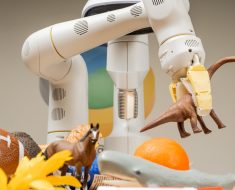In the realm of robotics, the evolution from mere
automation to the pursuit of artificial general intelligence (AGI) represents a
monumental shift in technological advancement.
Join us as we unravel the transformative journey of
robotics and its profound impact on the economy, from industrial automation to
the dawn of intelligent machines.
Welcome to the era of robotics, where machines are not
only performing repetitive tasks but also exhibiting capabilities akin to human
intelligence. The evolution of robotics from basic automation to the quest for
artificial general intelligence (AGI) marks a significant milestone in the
history of technology.
In this article, we’ll delve into the fascinating
journey of robotics, exploring its evolution, applications, and implications
for the economy and society at large.
Automation
The Foundation of Robotics
At the heart of robotics lies automation, the process
of using machines to perform tasks that were previously carried out by humans.
From industrial robots on factory floors to robotic
process automation (RPA) in administrative tasks, automation has revolutionized
industries by streamlining operations, increasing efficiency, and reducing
labor costs.
By automating repetitive and mundane tasks, robots
have freed up human workers to focus on more complex and creative endeavors,
driving productivity and innovation in the economy.
Advanced Robotics
Beyond Automation
While automation laid the foundation for robotics,
advances in artificial intelligence (AI), machine learning, and sensor
technology have propelled robotics into new realms of capability and
sophistication.
Today’s robots are equipped with advanced sensors,
actuators, and algorithms that enable them to perceive and interact with their
environment in increasingly intelligent ways.
From autonomous vehicles and delivery drones to
robotic assistants in healthcare and hospitality, advanced robotics is
expanding the possibilities of what machines can achieve, transforming
industries and reshaping the economy.
Machine Learning and Robotics
Machine learning plays a crucial role in the evolution
of robotics, enabling machines to learn from data and improve their performance
over time. By analyzing vast amounts of sensor data and feedback, robots can adapt
to changing environments, optimize their behavior, and even acquire new skills
autonomously.
Reinforcement learning algorithms, in particular, have
enabled robots to learn complex tasks through trial and error, mimicking the
way humans learn from experience.
As machine learning continues to advance, robots are
becoming more capable, versatile, and autonomous, paving the way for the
development of artificial general intelligence (AGI).
Artificial General Intelligence
The Next Frontier
Artificial general intelligence (AGI) represents the
pinnacle of robotic evolution – machines with the ability to understand, learn,
and apply knowledge across a wide range of tasks and domains, much like human
beings.
While current AI systems excel at narrow tasks within
specific domains, such as image recognition or natural language processing, AGI
aims to replicate the general intelligence exhibited by humans, enabling
machines to think, reason, and problem-solve in diverse contexts.
The pursuit of AGI holds immense promise and
potential, with implications for virtually every aspect of human society,
including the economy, healthcare, education, and beyond.
Applications of Robotics in the Economy
The impact of robotics on the economy is far-reaching,
with applications spanning various industries and sectors.
In manufacturing, robots have revolutionized
production processes, enabling mass customization, flexible manufacturing, and
just-in-time production. In logistics and supply chain management, robots are
streamlining warehouse operations, optimizing inventory management, and
enhancing order fulfillment efficiency.
In healthcare, robots are assisting surgeons in
complex procedures, providing companionship to elderly patients, and delivering
medication in hospitals. From agriculture and construction to finance and
retail, robotics is transforming the way we work, create value, and interact
with the world around us.
Challenges and Considerations
Despite the transformative potential of robotics,
challenges remain on the path to widespread adoption and integration.
Ethical considerations surrounding AI and automation,
including issues of job displacement, algorithmic bias, and privacy concerns,
must be addressed to ensure responsible development and deployment of robotic technologies.
Additionally, technical challenges such as
scalability, reliability, and interoperability pose significant hurdles in the
advancement of robotics, requiring continued research, innovation, and
collaboration across academia, industry, and government.
Final Thoughts
As we conclude our exploration of the evolution of
robotics, one thing becomes clear: we stand on the brink of a robotic
revolution that will reshape the economy and society in profound ways.
From automation and advanced robotics to the pursuit
of artificial general intelligence, robotics is driving innovation,
productivity, and economic growth across industries and sectors.
By embracing the potential of robotics and addressing
the challenges that lie ahead, we can harness the transformative power of
intelligent machines to create a future that is more efficient, equitable, and
sustainable for all.
Edited by Iman Fede
This article has been authored exclusively by the writer and is being
presented on Eat My News, which serves as a platform for the community to voice
their perspectives. As an entity, Eat My News cannot be held liable for the
content or its accuracy. The views expressed in this article solely pertain to
the author or writer. For further queries about the article or its content you
can contact on this email address – [email protected].




